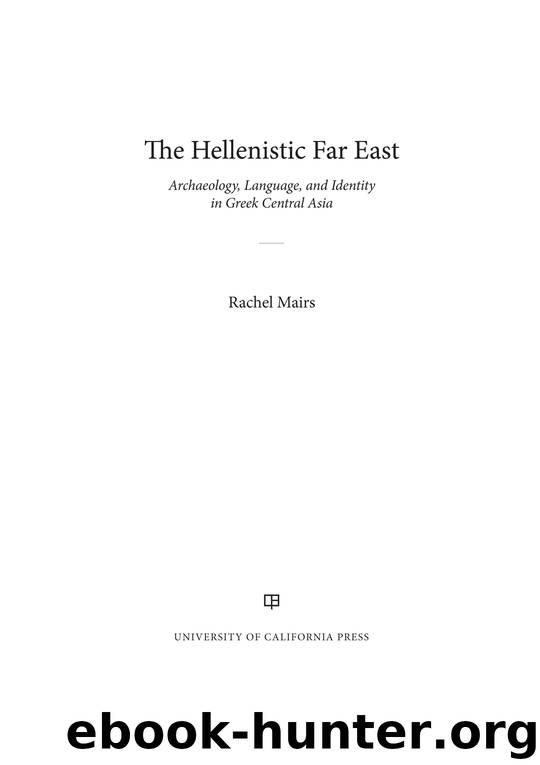The Hellenistic Far East by Mairs Rachel;

Author:Mairs, Rachel;
Language: eng
Format: epub
Publisher: University of California Press
BESNAGAR (VIDIŚĀ) AND BHĀGABHADRA
Besnagar, in the present-day Indian state of Madhya Pradesh, is the site of the ancient city of Vidiśā, which is mentioned in a number of ancient Indian textual sources and by the fourth century B.C.E. was a flourishing town on the trade route to southern India.80 The first description of the pillar’s immediate surroundings was given by Cunningham, who believed that it stood in the ruins of a monastery.81 The discovery of the inscription of Heliodoros, and subsequent interest in this, led to the first excavations in the vicinity of the pillar, carried out by Bhandarkar in 1914 and 1915.82 M. D. Khare, during excavations between 1963 and 1965, revealed traces of an elliptical temple-building, dated to the fourth century B.C.E.; nothing remained of the superstructure of the building.83 A Viṣṇu temple on a similar elliptical plan is known from fourth- or third-century-B.C.E. Nagari.84 This early Besnagar temple was destroyed at some point and rebuilt on a raised platform, the rubble retaining walls of which are preserved. The dates of the various phases of the site are not securely known.85
The pillar of Heliodoros was not the only one at the site, although it is the only one that currently remains standing. Three capitals—erroneously used by Cunningham in his proposed reconstruction of the pillar of Heliodoros—were found in the vicinity, and traces of several pits occur at uniform distances on a north-to-south alignment outside the temple’s rubble retaining wall.86 As in the archaeological remains of the temple and sanctuary, this permits us to reconstruct something of the wider cult practice at the site, of which the pillar of Heliodoros formed only a part. The question of the divinity worshipped and its relation to the cult of Viṣṇu will be considered further below.
The inscription of Heliodoros provides only tantalizing evidence regarding the political status of contemporary Besnagar. “King Kāsīputra Bhāgabhadra, the Savior,” appears in no other source under this name. In the absence of any firmer chronological anchor, the regnal date given (Year 14) cannot be used even to date the inscription, although it does at least give us a minimum length for his reign. His identity and status are a matter of debate: he may be a local ruler or a member of the Śunga dynasty, which controlled much of northern and northeastern India between about 185 and 73 B.C.E.87 This possible appearance of a Śunga king in the inscription of Heliodoros is often used as supporting evidence for the extent of Śunga rule in the Vidiśā region in the period around 110 B.C.E., but the fact of the matter is that our evidence is thin on the ground and open to varying interpretations. Leaving aside the debate over Śunga control in the region, a case can be made for Bhāgabhadra’s being a local ruler, whether or not he answered to any higher imperial authority.88 A second pillar from Besnagar bears an inscription dated in the twelfth year of one “King Bhāgavata,” possibly an alternative spelling of the name of the same king rather than simply the word for “devotee” (as in ll.
Download
This site does not store any files on its server. We only index and link to content provided by other sites. Please contact the content providers to delete copyright contents if any and email us, we'll remove relevant links or contents immediately.
The Daily Stoic by Holiday Ryan & Hanselman Stephen(3153)
The Fate of Rome: Climate, Disease, and the End of an Empire (The Princeton History of the Ancient World) by Kyle Harper(2927)
People of the Earth: An Introduction to World Prehistory by Dr. Brian Fagan & Nadia Durrani(2644)
Ancient Worlds by Michael Scott(2538)
Babylon's Ark by Lawrence Anthony(2463)
Foreign Devils on the Silk Road: The Search for the Lost Treasures of Central Asia by Peter Hopkirk(2396)
The Daily Stoic by Ryan Holiday & Stephen Hanselman(2391)
India's Ancient Past by R.S. Sharma(2334)
MOSES THE EGYPTIAN by Jan Assmann(2310)
The Complete Dead Sea Scrolls in English (7th Edition) (Penguin Classics) by Geza Vermes(2173)
Lost Technologies of Ancient Egypt by Christopher Dunn(2146)
The Earth Chronicles Handbook by Zecharia Sitchin(2123)
24 Hours in Ancient Rome by Philip Matyszak(1997)
Alexander the Great by Philip Freeman(1985)
Aztec by Gary Jennings(1901)
The Nine Waves of Creation by Carl Johan Calleman(1811)
Curse Tablets and Binding Spells from the Ancient World by Gager John G.;(1791)
Before Atlantis by Frank Joseph(1758)
Earthmare: The Lost Book of Wars by Cergat(1736)
